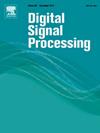Multi-graph mutual learning network with cross-modal feature fusion for video salient object detection
IF 3
3区 工程技术
Q2 ENGINEERING, ELECTRICAL & ELECTRONIC
引用次数: 0
Abstract
Video salient object detection (VSOD) aims to identify and highlight the most visually compelling and motion-related elements within video sequences, which serves as a crucial preprocessing step for intelligent video analysis. However, due to inadequate spatiotemporal cross-modal feature fusion and suboptimal capture of salient structure information, existing detection methods exhibit poor performance in numerous complex scenes. Such scenes typically involve moving objects but not salient in the background or rapid motion changes in foreground objects. To address this issue, we propose a multi-graph mutual learning network with cross-modal feature fusion for VSOD. Specifically, we design a cross-attention module (CAM) to effectively fuse spatiotemporal modal features. And we devise a multi-scale feature fusion module (MFFM) to fully integrate multi-scale features from different feature extraction layers. Finally, we propose a multi-graph mutual learning network (MGMLN) to improve the integrity and continuity of object structural information. Extensive experiments were conducted on four commonly used test datasets for VSOD. Our proposed method demonstrates the capability to accurately predict the most salient objects and maintain coherent details within complex dynamic visual scenes, when benchmarked against 21 state-of-the-art (SOTA) VSOD models.

基于跨模态特征融合的多图互学习网络用于视频显著目标检测
视频显著目标检测(VSOD)旨在识别和突出视频序列中视觉上最引人注目的运动相关元素,这是智能视频分析的关键预处理步骤。然而,由于时空跨模态特征融合不足和显著结构信息捕获不理想,现有的检测方法在许多复杂场景中表现不佳。这种场景通常包括移动的物体,但在背景中不突出,或者前景物体的快速运动变化。为了解决这个问题,我们提出了一个多图互学习网络的跨模态特征融合VSOD。具体来说,我们设计了一个交叉注意模块(cross-attention module, CAM)来有效地融合时空模态特征。设计了多尺度特征融合模块(MFFM),将不同特征提取层的多尺度特征充分融合。最后,我们提出了一种多图互学习网络(MGMLN)来提高目标结构信息的完整性和连续性。在四种常用的VSOD测试数据集上进行了大量的实验。当与21个最先进的(SOTA) VSOD模型进行基准测试时,我们提出的方法证明了在复杂的动态视觉场景中准确预测最显著物体和保持连贯细节的能力。
本文章由计算机程序翻译,如有差异,请以英文原文为准。
求助全文
约1分钟内获得全文
求助全文
来源期刊

Digital Signal Processing
工程技术-工程:电子与电气
CiteScore
5.30
自引率
17.20%
发文量
435
审稿时长
66 days
期刊介绍:
Digital Signal Processing: A Review Journal is one of the oldest and most established journals in the field of signal processing yet it aims to be the most innovative. The Journal invites top quality research articles at the frontiers of research in all aspects of signal processing. Our objective is to provide a platform for the publication of ground-breaking research in signal processing with both academic and industrial appeal.
The journal has a special emphasis on statistical signal processing methodology such as Bayesian signal processing, and encourages articles on emerging applications of signal processing such as:
• big data• machine learning• internet of things• information security• systems biology and computational biology,• financial time series analysis,• autonomous vehicles,• quantum computing,• neuromorphic engineering,• human-computer interaction and intelligent user interfaces,• environmental signal processing,• geophysical signal processing including seismic signal processing,• chemioinformatics and bioinformatics,• audio, visual and performance arts,• disaster management and prevention,• renewable energy,
 求助内容:
求助内容: 应助结果提醒方式:
应助结果提醒方式:


